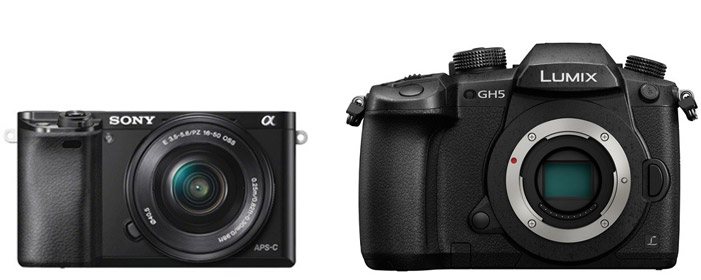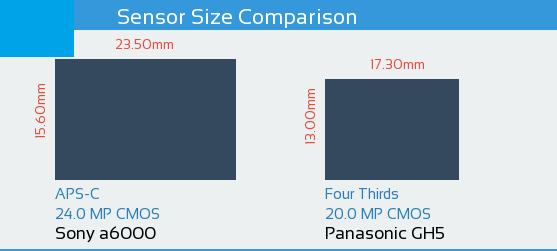Sony A6000 vs Panasonic GH5
: Here we compare and contrast the Sony Alpha A6000 and the Panasonic GH5. Two mirrorless cameras from two different companies. The Alpha A6000 with its 24.0MP APS-C sensor and the GH5 with its 20.0MP Four Thirds sensor. Here’s a brief overview of their main specifications before we get into more detail.
Sony A6000 vs Panasonic GH5 Specs

Sony A6000 vs Panasonic GH5 – Comparison
Specifications |
Sony A6000 |
Panasonic GH5 |
|---|---|---|
| Megapixels | 24.3 | 20.3 |
| Sensor Type | CMOS | Live MOS |
| Sensor Format | APS-C | Micro Four Thirds |
| Crop Factor | 1.5x | 2.0x |
| AA Filter | Yes | None |
| Image Resolution | 6000 x 4000 | 5184 x 3888 |
| Body Image Stabilization | No | Yes |
| Lens Mount | Sony E | Micro Four Thirds |
| ISO | 100 -25,600 | 200 – 25,600 |
| Expanded ISO | 51,200 | 100 |
| AF Points | 179 | 225 Contrast |
| Cross-type AF Points | 179 phase | 0 phase |
| Continuous Mode | 11fps | 12fps |
| LCD | 3.0″ – Articulating | 3.2″ – Fully Articulated |
| LCD Resolution | 921,600 dots | 1,620,000 dots |
| Touchscreen | No | Yes |
| Focus Peaking | Yes | Yes |
| Top LCD Display | No | No |
| Viewfinder Type | EVF (1.44M) | EVF (3.68M) |
| Viewfinder Coverage | 100% | 100% |
| Viewfinder Magnification | 1.07x | 1.52x |
| Video Resolution | 1920×1080 (60/24p) | 4096×2160 (24p) |
| 3840×2160 (60/50/30/25/24p) | ||
| Microphone Jack | No | Yes |
| Headphone Jack | No | Yes |
| Memory Card Type | SD or MS Pro | SD + SD |
| Dual Card Slots | No | Yes |
| SD UHS Support | UHS-I | UHS-II |
| Fastest Shutter Speed | 1/4000 | 1/16000 |
| Slowest Shutter Speed | 30″ | 60″ |
| Bulb Mode | Yes | Yes |
| JPEG Buffer Size | 47 | 600 |
| RAW Buffer Size | 22 | 60 |
| Time Lapse | Yes | Yes |
| Built-in Flash | Yes | No |
| Max Flash Sync Speed | 1/160 | 1/250 |
| Startup Time | 2.2s | |
| Built-in Wi-Fi | Yes | Yes |
| Built-in GPS | No | No |
| Built-in NFC | Yes | No |
| Bluetooth | No | Yes |
| USB Type | USB 2.0 | USB 3.0 |
| Environmentally Sealed | Yes | Yes |
| Battery Life (CIPA) | 360 shots | 410 shots |
| Battery Included | Yes (NP-FW50) | Yes |
| Weight | 12.1 oz (344g) | 25.6 oz (725g) |
| Size | 4.7 x 2.6 x 1.8″ | 5.5 x 3.9 x 3.4″ |
| Price | Amazon | Amazon |
| Release Date | 2014 | 2017 |
Panasonic GH5 vs Sony A6000 Common Features
| Wireless Connection | Yes vs Yes | Better connectivity |
| Articulating Screen | Yes vs Yes | Flexible shooting positions |
| External Flash Shoe | Yes vs Yes | Better for flash photography |
| Viewfinder | Yes (Electronic) vs Yes (Electronic) | Better framing and control |
| RAW Support | Yes vs Yes | Better image quality |
| Face Detection Focus | Yes vs Yes | Useful for portraits |
| Max Resolution | 24 MP vs 20 MP | Bigger prints and more details |
| LCD Screen Size | 3″ vs 3.2″ | Large display |
| LCD Screen Resolution | 922k dots vs 1.620k dots | Higher resolution screens |
| Continuous Shooting | 11.0fps vs 12.0fps | Fast shooting speeds |
| AE Bracketing | Yes vs Yes | Useful for tough lighting conditions and HDR |
Sony A6000 vs Panasonic GH5 Size Comparison
With regard to size, the Sony A6000 is the smaller of the two cameras. Its body is 19mm narrower, 31mm shorter and 42mm thinner than Panasonic GH5. Furthermore, the Sony A6000 is significantly lighter (381g ) than the Panasonic GH5. Something you ought to consider when you plan on having long sessions without a tripod or carrying your camera around.

Sony A6000 vs Panasonic GH5 – Comparison
Also, an additional factor to weight is the lenses that you plan to use with your digital cameras. The Lumix GH5 features a smaller Four Thirds sensor. Hence, Panasonic’s lenses at a similar aperture and focal lend tend to be lighter than those for Sony’s A6000.
Sony A6000 vs Panasonic GH5 Sensor Comparison
The Sony A6000 has a 24.0MP APS-C (23.5 x 15.6 mm ) sized CMOS sensor and features a Bionz X processor. The Panasonic Lumix GH5 has a 20.0MP Four Thirds (17.3 x 13 mm ) sized CMOS sensor and features Venus Engine processor.
The Panasonic GH5’s sensor lacks an anti-alias (Low-Pass) filter. This is good as your images tend to be sharper and more detailed. However, there is also a chance that some scenes may have slight moire.

Sony A6000 vs Panasonic GH5 Sensor Comparison
The Sony A6000 has a 1.6x Larger sensor area than Panasonic’s GH5. Larger sensors allow for more control over the depth of field and blurry background compared to smaller sensors when shot in same focal length and aperture.
Why You Should Choose The Panasonic GH5
| Built-in Image Stabilization | Sensor-shift vs None | All the lenses are stabilized |
| Touch Screen | Yes vs No | Easy control of camera functions |
| Number of Focus Points | 225 vs 179 | 46 more focus points |
| LCD Screen Size | 3.2″ vs 3″ | 0.2 inches larger display |
| LCD Screen Resolution | 1.620k dots vs 922k dots | 75% higher resolution screen |
| Max Shutter Speed | 1/8000s vs 1/4000s | Faster shutter speed |
| Continuous Shooting | 12.0fps vs 11.0fps | 1 fps faster |
| Battery Life | 410 shots vs 360 shots | 50 more frames with a single charge |
| Microphone Port | Yes vs No | High-quality audio recording option |
| Headphone Port | Yes vs No | Better video control |
| Environmental Sealing | Yes vs No | Shoot at tough conditions |
| Timelapse Recording | Yes vs With optional app | Creative shooting |
| Viewfinder Resolution | 3680k dot vs 1440k dot | 155% higher resolution |
| Max Video Resolution | 4096 x 2160 vs 1920 x 1080 | Higher Resolution Video |
| Flash Sync Port | Yes vs No | Connect off-camera flash |
| Selfie Friendly LCD | Yes vs No | Rotate LCD for taking Selfies |
| 4K Photo Mode | Yes vs No | Extract 8MP photos from 4K Video |
| 6K Photo Mode | Yes vs No | Extract 18MP photos from Video footage |
| Bluetooth | Yes vs No | Connect your camera to other devices via Bluetooth |
| Focus Stacking | Yes vs No | Stacks photos in-camera to maximize depth of field |
| Post Focus Mode | Yes vs No | Change focus point after taking a shot |
| Storage Slot | 2 vs 1 | Extra storage slot |
| Smartphone_remote control | Yes vs No | Remote control your camera with a smartphone |
| Support for UHS Memory Cards | UHS-II vs none | Read/Write in Ultra High Speeds |
Advantages of the Panasonic GH5 Over the Sony A6000
- AA Filter – The Panasonic GH5 has no AA filter.
- Body Image Stabilization – The Panasonic GH5 has built-in body stabilization for photos and videos, which is an excellent feature for traveling and shooting in low light.
- AF Points – 225 Contrast vs 179.
- Continuous mode – 12fps vs 11fps. It’s an advantage, but not something you will really notice that often.
- LCD – 3.2″ vs 3.0″ and it’s fully articulated.
- LCD Resolution – Higher resolution
- Touchscreen Support
- Viewfinder Magnification – Higher magnification.
- Video Resolution – 4K video available.
- Microphone Jack – If you’re going to record videos where audio quality is important, a microphone jack is super helpful.
- Headphone Jack – Useful for previewing your audio quality straight out the camera.
- Dual Card Slots – More room for extra photos, or simply for backup.
- UHS-II – Faster writing speeds than UHS-I, but you need a memory card that can handle such speeds.
- Faster Max Shutter Speed – 1/16000 vs 1/4000.
- Slower Max Shutter Speed – 60” vs 30”.
- JPEG Buffer Size – 600 vs 47.
- RAW Buffer Size – 60 vs 22.
- Max Flash Sync Speed – 1/250 vs 1/160.
- Bluetooth Support
- USB 3.0 – Faster file transferring out the camera.
Video: Panasonic Lumix GH5 Hands-on Review
Why You Should Choose The Sony A6000
| Built-in Flash | Yes vs No | Useful in low-light |
| Max Sensor Resolution | 24 MP vs 20 MP | 19% more pixels |
| Weight | 344 g vs 725 g | 381 g lighter |
| Sensor Pixel Area | 15.28µm2 vs 11.16µm2 | 36% larger pixel area |
| Price | $498 vs $1,998 | $1,500 cheaper |
| NFC Connection | Yes vs No | Easy wireless connectivity with compatible devices |
Advantages of the Sony Alpha A6000 Over the Panasonic GH5
- Megapixels – 4.0 more megapixels. For printing big and cropping, the Sony A6000 is a much better choice.
- Sensor Format – APS-C is bigger than MFT, which results in slightly less noise at higher ISO levels.
- ISO – 51,200 vs 25,600. Higher maximum ISO sensitivity.
- Cross-type AF Points – 179 phase vs 0 phase.
- Built-in Flash
- Built-in NFC
- Weight – The Sony A6000 weighs 381g less.
- Size – The Sony A6000 is noticeably smaller.
- Price – The Sony A6000 is much cheaper